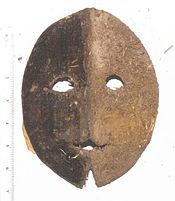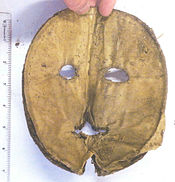A visard, also known as a vizard, is an oval mask of black velvet which was worn by travelling women in the early modern period to protect their skin from sunburn.[1] The fashion of the period for wealthy women was to keep their skin pale, because a tan suggested that the bearer worked outside and was hence poor. Some types of vizard were not held in place by a fastening or ribbon ties, and instead the wearer clasped a bead attached to the interior of the mask between their teeth. [2]



The practice did not meet universal approval, as evidenced in this excerpt from a contemporary polemic:
When they use to ride abroad, they have visors made of velvet ... wherewith they cover all their faces, having holes made in them against their eyes, whereout they look so that if a man that knew not their guise before, should chance to meet one of them he would think he met a monster or a devil: for face he can see none, but two broad holes against her eyes, with glasses in them.
— Phillip Stubbes, Anatomy of Abuses (1583)
In Venice, the visard developed into a design without a mouth hole, the moretta, and was gripped with a button between the teeth rather than a bead. The mask's prevention of speech was deliberate, intended to heighten the mystery of a masked woman even further.[4]
Notable wearers
editA Spanish observer at the wedding of Mary I of England and Philip of Spain in 1554 mentioned that women in London wore masks, antifaces, or veils when walking outside.[5][6] Masks became more common in England in the 1570s, leading Emanuel van Meteren to write that "ladies of distinction have lately learned to cover their faces with silken masks and vizards and feathers".[7]
In Scotland in the 1590s, Anne of Denmark wore masks when horse riding to protect her complexion from the sun.[8] These were faced with black satin, lined with taffeta, and supplied with Florentine ribbon for fastening and for decoration.[9] On some later public occasions she did not wear a mask outdoors. In June 1603, after she travelled to England for the Union of Crowns, John Chamberlain said she had done "some wrong" to her complexion "for in all this journey she hath worn no mask".[10] In September, Arbella Stuart praised her for greeting the populace at Newbury with "thankful countenance barefaced to the great contentment of native and foreign people."[11] When the Spanish ambassador Juan Fernández de Velasco y Tovar, 5th Duke of Frías, arrived by ship to negotiate the Treaty of London the following year, she wore a black mask while observing from a barge on the Thames.[12][13]
Elizabeth I had masks lined with perfumed leather and made with satin supplied by Baptist Hicks. In September 1602, she was observed wearing a mask while walking in the garden at Oatlands Palace.[7] In 1620 the lawyer and courtier John Coke sent clothes and costume to his wife, including a satin mask and two green masks for their children.[14]
Visards experienced a resurgence in the 1660s. In 1663, after attending a play at the Theatre Royal, Drury Lane, Samuel Pepys noted in his diary that as the venue began to fill Mary Cromwell "put on her vizard, and so kept it on all the play; which of late is become a great fashion among the ladies, which hides their whole face." Later that day, he bought a vizard for his wife.[15]
See also
editCitations
edit- ^ Holme (1688).
- ^ Elgin (2005).
- ^ Portable Antiquities Scheme (2010).
- ^ Steward & Knox (1996), p. 56.
- ^ Muñoz (1877), p. 77.
- ^ Linthicum (1936), p. 272.
- ^ a b Arnold (1988), p. 12.
- ^ Pearce (2019).
- ^ Field (2019).
- ^ Lee (1972), pp. 34–5.
- ^ Steen (1994), p. 184.
- ^ Anonymous (1604), p. 22.
- ^ Green (1856), p. 141.
- ^ HMC (1888), p. 108.
- ^ Pepys (1967).
References
edit- Arnold, Janet (1988). Queen Elizabeth's Wardrobe Unlock'd. Maney. p. 12. ISBN 9780901286208.
- Relacion de la Jornada de Condestable de Castilla en Londres 1604. Antwerp. 1604.
- Elgin, Kathy (2005). Elizabethan England. Infobase Publishing. p. 38. ISBN 9781438121239.
- Field, Jemma (August 2019). "Dressing a Queen: The Wardrobe of Anna of Denmark at the Scottish Court". The Court Historian. 24 (2): 163. doi:10.1080/14629712.2019.1626120.
- Green, Mary Anne Everett, ed. (1856). Calendar of state papers, Domestic series, of the reign of James I. 1603—1610. London: Public Record Office.
- Historical Manuscripts Commission (1888). Twelfth Report of the Historical Manuscripts Commission, Appendix, Part I. The Manuscripts of the Earl Cowper, K.G., Preserved at Melbourne Hall, Derbyshire. Vol. 1. London: Eyre and Spottiswoode.
- Holme, Randal (1688). The Academie of Armorie.
A mask [is] a thing that in former times Gentlewomen used to put over their Faces when they travel to keep them from Sun burning... the Visard Mask, which covers the whole face, having holes for the eyes, a case for the nose, and a slit for the mouth, and to speak through; this kind of Mask is taken off and put in a moment of time, being only held in the Teeth by means of a round bead fastened on the inside over against the mouth.
- Linthicum, M. Channing (1936). Costume in the Drama of Shakespeare and his Contemporaries. Oxford: Clarendon Press.
- "Mask". Portable Antiquities Scheme. 2010.
- Lee, Maurice (1972). Dudley Carleton to John Chamberlain, 1603-1624. New Brunswick: Rutgers University Press.
- Muñoz, Andrés. (1877). de Gayangos, Pascual (ed.). Viaje de Felipe Segundo á Inglaterra. Madrid: Imprenta de Aribau y C.a.
- Pearce, Michael (August 2019). "Anna of Denmark: Fashioning a Danish Court in Scotland". The Court Historian. 24 (2): 142. doi:10.1080/14629712.2019.1626110.
- Pepys, Samuel (1967). "June 12, 1663". In Le Gallienne, Richard (ed.). The Diary of Samuel Pepys. New York City: The Modern Library. On Wikisource: Diary of Samuel Pepys, Friday, 12 June 1663.
- Steward, James Christen; Knox, George (1996). The mask of Venice: masking, theater & identity in the art of Tiepolo & his time. Berkeley Art Museum and Pacific Film Archive. ISBN 9780295976112.
- Stuart, Arbella (1994). Steen, Sara Jayne (ed.). The Letters of Lady Arbella Stuart. Oxford University Press.
External links
edit- Details of a visard in the collection of the Norwich Castle Museum
- A miniature visard made for a 17th-century child's doll in the collection of the Victoria and Albert Museum

